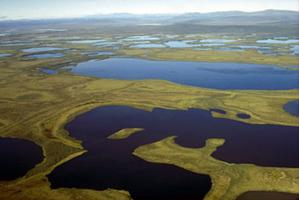Old Crow Basin is an important geographic feature in the natural history and human history of Canada. It is the largest of four interior lowland areas within northern Yukon Territory (the others being Bluefish, Bell and Bonnet Plume basins). Sediments washed into these basins built up deep deposits that buried and preserved the remains of many varieties of plants and animals, creating a fossil record locked in permafrost and spanning more than a million years.
All of the basins formerly drained through rivers running to the Mackenzie Delta (see Mackenzie River), but a complex series of changes during the last ice age (the Wisconsinan) caused a new outlet to be cut at the "Ramparts" of Porcupine River and diverted the drainage of Old Crow, Bluefish and Bell basins westward into Alaska. As a result, many northern Yukon rivers, including Old Crow River and Porcupine River, cut through the fossil-bearing deposits, creating vertical bluffs more than 30 m high. Millions of fossils were eroded from the bluffs, and particularly in Old Crow Basin they were redeposited in and on newly formed riverbanks and bars.
Fossils and Artifacts
The fossils represent many fascinating animals, including extinct forms such as mammoths, mastodons, giant beavers, ground sloths, camels, several kinds of horses, giant bison, short-faced bears, American lions, short-faced skunks and many more. Some of the mammoth bones are broken in distinctive ways reminiscent of human butchery and tool production, and a selection of these yielded radiocarbon dates between 25 000 and 40 000 years old. These may be the oldest artifacts yet discovered in Canada.
Old Crow Basin has played an important role in human history ever since. The basin lies on the migratory pathway of the Porcupine caribou herd that still numbers an estimated 123 000 animals. The Gwich'in natives have long relied upon caribou hunting for their livelihood, and they developed ingenious methods of intercepting the migrating herds. The northbound spring migration would be met at favoured crossing places along Porcupine River, where large villages were established at sites such as Klo-kut and Rat Indian Creek. These villages were the ancient counterparts to the modern community of Old Crow, where the people still launch their boats to find the caribou crossing the river. The southbound fall migration was formerly intercepted at the north edge of Old Crow Basin, where caribou fences up to several km in length equipped with snares were constructed just within the northern limit of spruce trees. Hundreds of caribou could be captured in a single day, the meat and hides being essential to surviving the long winter. Now the people of Old Crow watch the skyline of Old Crow mountain to see the caribou congregating after a scattered crossing of Old Crow Basin.
Importance
Old Crow Basin is also a major breeding ground for many species of birds, especially waterfowl, and for a large population of beavers and muskrats. These furbearers have been a mainstay to the Old Crow economy during its recent history. The importance of the basin is shown by the inclusion of its northern half in the Vuntut National Park, to protect the habitat of the Porcupine caribou herd and various species of migratory birds. The long-term success of this initiative will depend upon US decisions on oil and gas exploration in the caribou calving grounds within Alaska's Arctic National Wildlife Refuge.
See also Archaeology; Prehistory.

 Share on Facebook
Share on Facebook Share on X
Share on X Share by Email
Share by Email Share on Google Classroom
Share on Google Classroom



